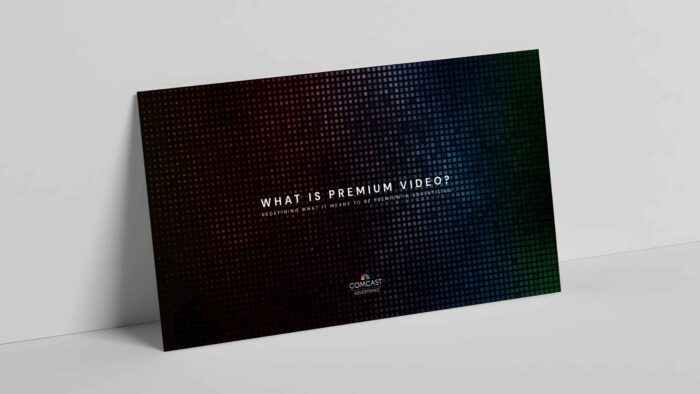For all the talk of smartphones and other portable devices dominating consumer attention, households still spend nearly six hours a day watching TV, according to The TV Viewership Report produced in March by Effectv.1 And despite the popularity of time-shift viewing2 and the number of ad-free streaming services available, the majority of American viewers are still consuming plenty of what they consider “TV” with ads, much of it on a large display in their home.
Effectv recently completed a survey to understand just how consumers now define TV. The report for the study is forthcoming, but an early look at the responses show participants were most likely to say TV is the “physical device” (i.e., the TV display) at 71 percent. This was followed by “type of content” at 65 percent, and “the service it is watched on or through” at 58 percent. In addition, younger audiences were more likely to consider the type of content while older audiences were more likely to consider the device when asked how they define “TV.” Effectv conducted a similar survey in 2019 and the device was also the top choice among respondents then.
Those results mirror a similar study by the Video Advertising Bureau, which found that 47 percent of those aged 18 to 50 and 58 percent of those older than 50 defined TV as anything they can watch on a TV set regardless of whether it comes from a streaming device, cable, or satellite.
Even the rapid growth in recent years of high-profile streaming services, including Paramount+, Peacock, and Disney+, hasn’t really changed how consumers define TV, says Travis Flood, executive director of insights at Comcast Advertising.
When people watch streaming content, about 80 percent of that is happening on the TV screen. When audiences have the opportunity to choose, they are picking the largest, most engaging screen in the household.
Travis Flood, Executive Director of Insights, Comcast Advertising
Fifteen- and 30-second spots seen on those larger screens still pack a much greater wallop when compared to ads served to consumers in a feed-based mobile environment, Flood says, referring to a recent Comcast Advertising study titled “TV Makes Memories.”
“Ads delivered in the TV/CTV (connected TV) environment had greater unaided recall and purchase intent versus ads delivered in a mobile environment,” Flood says. “Two ad exposures in the TV environment had 2.2 times higher unaided recall than two ad exposures in the mobile environment. Similarly, purchase intent was 1.3 times higher for the ads in the TV environment.”

Participants also viewed ads longer in a traditional TV environment, regardless of whether it was delivered via linear or streaming.
“While the device itself may be a factor in attention, generally it’s the experience that contributes most to attention,” Flood says. “In the same study participants also rated the overall enjoyment and quality of the TV experience better,” he says.
FAST, AVOD, and the Cost-conscious Viewer
The recent growth of free ad-supported streaming television (FAST) and ad-supported video on demand (AVOD) streaming services is enabling brands to begin adding audience extensions into their buying mix. But Flood points out that this still has to be viewed as additional reach, rather than a replacement for traditional linear TV platforms, even when looking for those young adults more apt to be cord cutters.
“What we’re advocating for is building reach by combining the power of both traditional TV and streaming,” Flood says. “We’ve found that advertisers can maximize reach when they allocate 20 to 30 percent of their investment to streaming. Anything beyond that generally has diminishing returns for the advertiser.”
That percentage could change going forward, but Flood and others point out that many viewers who opted for less-expensive cord-cutting alternatives still watch TV in much the same way they did prior to broadband and streaming.
Annie Hagerty, a Comcast Advertising analyst who worked on the latest study, says ad exposure data shows viewers are watching much of the same content on newer FAST platforms as they did when viewing linear TV.
“News is one of the largest FAST content genres, which is very similar to how viewers watch linear TV,” she says. “Within FAST, comedy and education or documentary [programming] is also a large share of the genre viewing. And when we drilled into the AVOD genres, comedy, drama, and reality were the larger categories.”
Increasingly more viewers now use streaming platforms not for ad-free binge watching but for a traditional viewing experience that begins with going to the channel guide, which Effectv refers to as a “lean back” viewing experience.
“Brands today are truly embracing all the benefits of reaching viewers through streaming advertising and are increasingly realizing the benefits of new FAST services, says Katy Loria, chief revenue officer at FreeWheel, Comcast Advertising’s advertising technology platform. “These media types give them the opportunity to reach targeted, engaged audiences on premium content at scale — it’s essentially the best of TV and the best of digital in one place.”
Flood adds that FAST services have higher viewing times than AVOD. “When faced with so many choices, consumers are going back to just scrolling through a guide to see what’s on then,” he says.
Many of the premium-content streaming providers are now adding (or considering) lower-priced ad-supported tier options for viewers, which should provide more advertising opportunities for brands, as well as the opportunity for messages to be showcased alongside long-form compelling content.
But with 78 percent of multiscreen advertising reach still coming from traditional TV, per Effectv’s “The TV Viewership Report,” advertisers looking for reach and frequency at scale still should look to linear TV for most of the heavy lifting for the foreseeable future.
“It’s changing, but it’s not changing as drastically as people may think overall,” Flood says. “Traditional TV provides a lot of viewers [and] so it should remain the foundation. Streaming can then provide incremental reach, so reporting on them together can be a real advantage
This content has been modified from the original article published here on ANA.net.
Sources:
1. The TV Viewership Report 2H 2022, Effectv, 2023.
2. Global Cloud DVR Market 2023-2027, Research and Markets, 2022.



